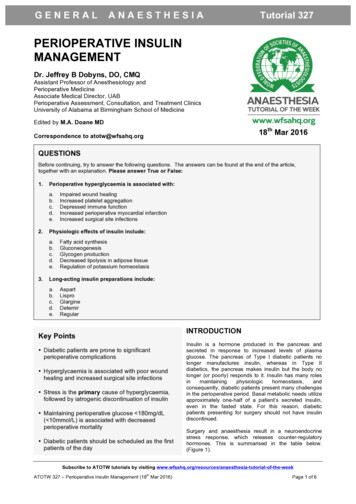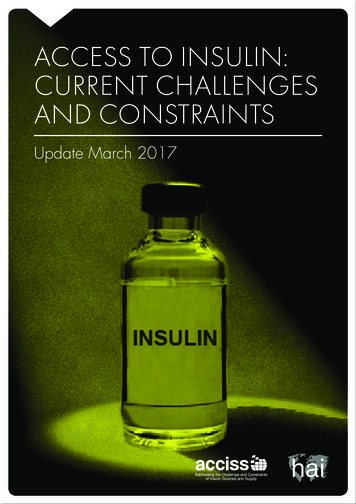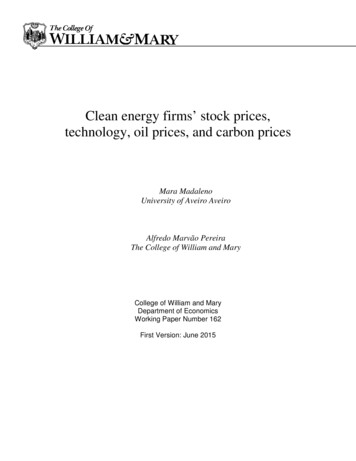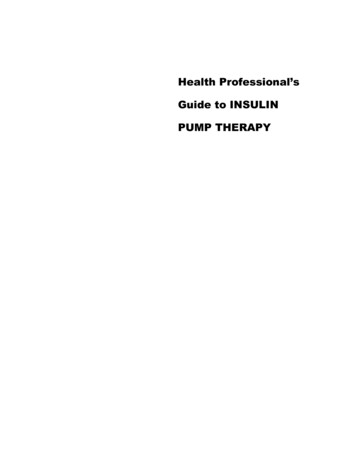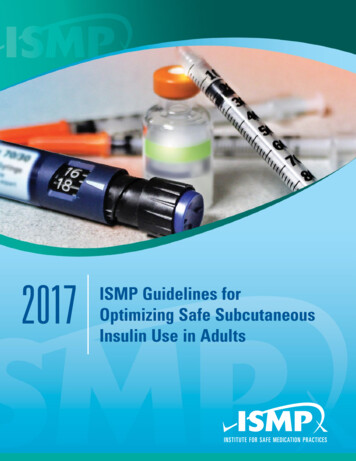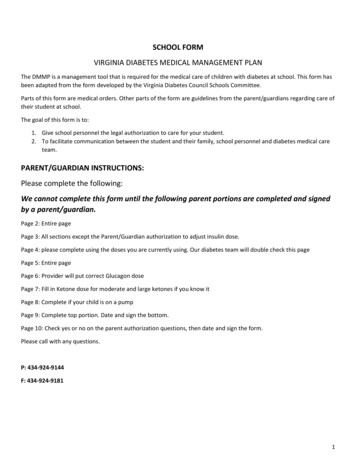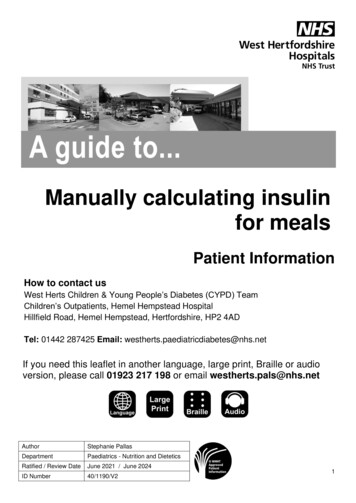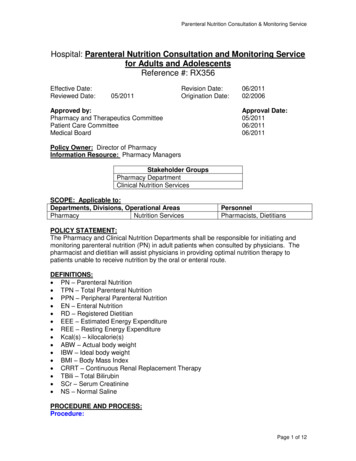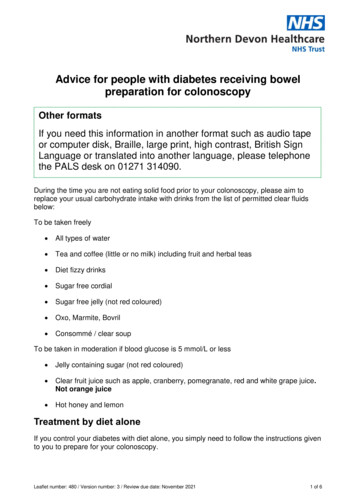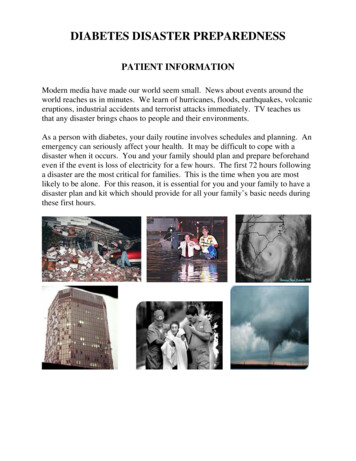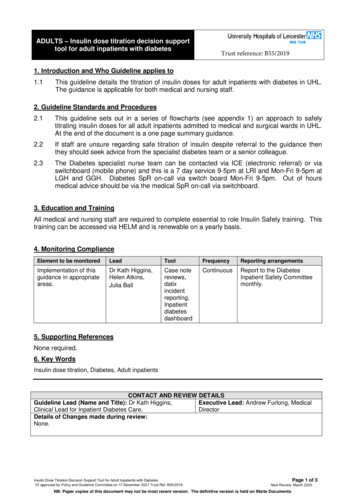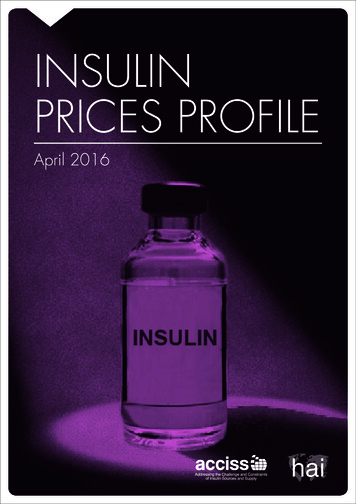
Transcription
INSULINPRICES PROFILEApril 2016
INSULINPRICES PROFILEApril 2016Margaret EwenHealth Action InternationalHuibert-Jan JoosseMasters student, University of UtrechtDavid BeranGeneva University Hospitalsand University of GenevaRichard LaingBoston University School of Public HealthPaul AshigbieDrPH student, Boston UniversitySchool of Public HealthPublished byHealth Action InternationalOvertoom 60 (2) 1054 HK AmsterdamThe Netherlands 31 20 412 4523www.haiweb.orgDisclaimerThe ACCISS Study is supported by The LeonaM. and Harry B. Helmsley Charitable Trust and StichtingICF. The analysis included in this report is that of theauthors alone and does not necessarily reflect the viewsof the Helmsley Charitable Trust or Stichting ICF. All references and conclusions are intended for educational andinformative purposes and do not constitute an endorsement or recommendation from the Helmsley CharitableTrust and Stichting ICF.LicensingThis report is licensed under the Creative Commons Attribution-NonCommercial 4.0 International Licence. Youmay share and adapt this material if you give appropriatecredit, provide a link to the licence, and indicate if changes were made. You may not use the material for commercial purposes. To view a copy of this licence, /.
Co n te n tsAcro n ym s . 4Exe cu tive Su m m ary . 51.In tro d u ctio n . 91.1 ACCISS Stu dy . 91.2 Th e In s u lin Price s Pro file . 92.Me th o d o lo gy . 122 .1 D ata Co lle ctio n an d En try . 122 .2 D ata Ch e ckin g . 142 .3 D ata An alys is . 143.Re s u lts . 173 .1 MSH In s u lin Su p plie r an d Bu ye r Price s . 173 .1.1 In s u lin Su pp lie r Price s . 173 .1.2 In s u lin Bu ye r Price s . 2 03 .2 MSH In s u lin Price s Co m p are d to Oth e r Me dicin e s . 2 73 .3 Go ve rn m e n t In s u lin Pro cu re m e n t Price s an d Vo lu m e s . 3 13 .3 .1 Price An alys is by In s u lin Type . 3 13 .3 .2 Price An alys is by Co u n try fo r Se le cte d H u m an In s u lin s . 3 23 .3 .3 Price An alys is by W o rld Ban k In co m e Gro u p . 3 43 .3 .5 Price An alys is by Pre s e n tatio n fo r Se le cte d H u m an an d An alo gu eIn s u lin s . 3 53 .3 .6 Price An alys is by Bran d . 3 73 .3 .7 Price An alys is by Bran d an d Pre s e n tatio n fo r s e le cte d H u m an an dAn alo gu e In s u lin s . 3 83 .3 .8 An n u al Pro cu re m e n t Vo lu m e s . 3 93 .3 .9 Co rre latio n be tw e e n Pro cu re m e n t Price an d Vo lu m e o f Pu rch as e . 4 13 .3 .10 Po te n tial Savin gs fro m Pro cu rin g On ly H u m an In s u lin . 4 23 .4 In s u lin Patie n t Price s in th e Pu blic an d Private Se cto r . 4 3Patie n t Price s o f An im al In s u lin . 4 43 .4 .1 Su m m ary Patie n t Price s fo r H u m an an d An alo gu e In s u lin s . 4 43 .4 .2 Patie n t Price s fo r H u m an In s u lin by Type . 4 53 .4 .3 Patie n t Price s fo r H u m an In s u lin by W o rld Ban k In co m e Gro u p . 4 53 .4 .4 Co rre latio n Be tw e e n Patie n t Price s an d GD P/ GD Pp c fo r H u m anIn s u lin . 4 73 .4 .5 Patie n t Price s fo r H u m an In s u lin by Co u n try . 4 73 .4 .6 Patie n t Price s fo r H u m an In s u lin by Bran d . 4 93 .4 .7 Patie n t Price s fo r An alo gu e In s u lin by Typ e . 503 .4 .8 Patie n t Price s fo r An alo gu e In s u lin by W o rld Ban k In co m e Gro u p . 513 .4 .9 Co rre latio n be tw e e n Patie n t Price s an d GD P/ GD Pp c fo r An alo gu eIn s u lin . 523 .4 .10 Patie n t Price s fo r An alo gu e In s u lin by Co u n try . 533 .4 .11 Patie n t Price s fo r An alo gu e In s u lin by Bran d . 543 .4 .12 Patie n t Price s by Pre s e n tatio n , H u m an an d An alo gu e In s u lin s . 553 .5 Go ve rn m e n t Mark-u p s in th e Pu blic Se cto r . 593 .6 In s u lin Affo rd ability in th e Pu blic an d Private Se cto r . 6 0Affo rd ability o f An im al In s u lin . 6 03 .6 .1 Su m m ary Affo rd ability fo r H u m an an d An alo gu e In s u lin s . 6 03 .6 .2 Affo rdability by W o rld Ban k In co m e Gro u p , Pu blic Se cto r . 6 13 .6 .3 Affo rd ability by In s u lin Typ e , Bran d an d Co u n try, Pu blic Se cto r . 6 2INSULIN PRICES PROFILE 2
3 .6 .4 Affo rd ability by W o rld Ban k In co m e Gro u p , Private Se cto r . 6 43 .6 .5 Affo rd ability by In s u lin Typ e , Bran d an d Co u n try, Private Se cto r . 6 53 .7 Re im bu rs e m e n t Price s . 6 83 .7.1 Re im bu rs e m e n t Price s by In s u lin Type , H u m an an d An alo gu e In s u lin s. 6 83 .7.2 Co rre latio n Be tw e e n Re im bu rs e m e n t Price s an d GD P/ GD Ppc, H u m anan d An alo gu e In s u lin s . 6 93 .7.3 Re im bu rs e m e n t Price s by Bran d , H u m an an d An alo gu e In s u lin s . 703 .7.4 Re im bu rs e m e n t Price s by Pre s e n tatio n , H u m an an d An alo gu e In s u lin s. 723 .7.5 Re im bu rs e m e n t Price s by W o rld Ban k In co m e Gro u p . 733 .7.6 Re im bu rs e m e n t Price s by Co u n try . 743 .8 Ove rall Co m p aris o n o f Price s fo r Se le cte d H u m an an d An alo gu e In s u lin s. 763 .9 Price Co m p o n e n ts in th e Ph arm ace u tical Su p ply Ch ain . 784.D is cu s s io n . 8 05.Co n clu s io n s . 8 56.Re fe re n ce s . 8 6An n e x 1. Co u n trie s an d p rice typ e s in th e an alys e s . 8 9An n e x 2 . Ran ge s o f MSH in s u lin ad ju s te d bu ye r p rice s , all type s o f in s u lin pe r10 m l 10 0 IU vial, 19 9 6 -2 0 13 , by W H O Re gio n an d W o rld Ban k In co m e Gro u p 9 2An n e x 3 . Fre qu e n cy o f MSH in s u lin ad ju s te d bu ye r p rice s be lo w , e qu al o r abo veth e m e dian price , 19 9 6 -2 0 13 , by W H O re gio n an d W o rld Ban k In co m e Gro u p s 9 6An n e x 4 . Me an an n u al ad ju s te d p rice ( D D D in U SD ) , pe rce n tage o f p e r capitaGD P s p e n t o n in s u lin p e r pe rs o n , n u m be r o f p e o ple re qu irin g in s u lin an d to talco s t o f in s u lin in e ach co u n try . 9 9An n e x 5. Me an go ve rn m e n t p ro cu re m e n t p rice s , U SD 10 m l 10 0 IU , fo r e achin s u lin typ e p e r co u n try . 10 1An n e x 6 . Go ve rn m e n t p ro cu re m e n t price s , U SD fo r 10 m l 10 0 IU in s u lin , in e achco u n try by bran d an d p re s e n tatio n . 10 4An n e x 7. Sign ifican t co rre latio n p lo ts fo r go ve rn m e n t p ro cu re m e n t price s ,p atie n t p rice s an d re im bu rs e m e n t p rice s . 10 9An n e x 8 . Me an p atie n t p rice s ( U SD ) an d affo rd ability ( d ays ’ w age s ) fo r 10 m l10 0 IU by bran d an d co u n try, in th e p u blic s e cto r . 115An n e x 9 . Me an p atie n t p rice s ( U SD ) an d affo rd ability ( d ays ’ w age s ) by bran dan d co u n try, in th e private s e cto r . 12 0An n e x 10 . N atio n al in s u lin re im bu rs e m e n t in fo rm atio n an d p atie n tco n tribu tio n s . 13 1An n e x 11. Re im bu rs e m e n t price s by in s u lin type an d pre s e n tatio n . 13 4An n e x 12 . Re im bu rs e m e n t price s by bran d . 13 6An n e x 13 . Re im bu rs e m e n t price s by bran d an d p re s e n tatio n . 13 9An n e x 14 . Re im bu rs e m e n t price s by bran d an d co u n try . 14 3INSULIN PRICES PROFILE 3
An n e x 15. Co n tribu tio n o f bas e p rice s ( CIF/ MSP) an d ad d -o n s to th e fin alp atie n t p rice s by W H O Re gio n . 154INSULIN PRICES PROFILE 4
Acro n ym sACCISSARVDDDEMLGCCGDPGDPpcHAIHIV/ AIDSIDFIIFLMICMSHNCD(s)UHCUKUNUSUSDUNRWAWHOWHO AFROAddressing the Challenge and Constraints of Insulin Sources and SupplyAntiretroviralDefined Daily DosageEssential Medicines ListGulf Cooperation CouncilGross Dom estic ProductGross Dom estic Product per capitaHealth Action InternationalHum an Im m unodeficiency Virus / Acquired Im mune Deficiency SyndromeInternational Diabetes FederationInternational Insulin FoundationLow and Middle-Incom e CountriesManagem ent Sciences for HealthNon-com municable diseasesUniversal Health CoverageUnited KingdomUnited NationsUnited States of Am ericaUnited States DollarUnited Nations Relief and Works Agency for Palestine Refugees in the NearEastWorld Health OrganizationWorld Health Organization African Regional OfficeINSULIN PRICES PROFILE 5
Exe cu tive Su m m aryIn m id-20 15, a tim e series analysis was conducted on Managem ent Sciences for Health(MSH) International Drug Price Indicator Guide insulin supplier and buyer prices, and asurvey was conducted on insulin prices i.e. governm ent procurem ent prices and volum es,patient prices and affordability (in the public and private sectors), and reim bursem ent prices.Me th o d o lo gyMSH insulin prices from 1996 to 20 13 were obtained for both suppliers and purchasers fromthe online International Drug Price Indicator Guide. Prices were standardised to 10 m l10 0 IU/ m l insulin and adjusted using the US Departm ent of Labor Bureau of Labor Statisticsconsum er price index and adjusted to 1996 prices. To enable comparisons, MSH prices werealso analysed for six non-com m unicable (NCD) medicines and three m edicines to treatHIV/ AIDS. Governm ent procurem ent prices of insulins were collected from nationalm edicine procurem ent officers in 26 countries and two organizations (Gulf CooperationCouncil, GCC and United National Relief and Works Agency for Palestine Refugees,UNRWA). Requests for patient prices were m ade directly to people who have undertakenWHO/ HAI price surveys, m em bers of various networks and via listserv requests. Prices wereprovided for 43 countries.Reim bursem ent prices were obtained from publicly accessible databases for national socialinsurance schem es. Data were obtained from 28 countries. Procurem ent prices wereadjusted, according to the INCO term , to cover costs to the national central store. All priceswere standardized to 10m l of 10 0 IU/ m l insulin in US dollars. Where more than one price wasrecorded for a product, the m ean price was taken. Based on m edian prices, affordability wasexpressed as the number of days the lowest paid unskilled governm ent worker would have towork to buy 10 m l of insulin.Fin d in gsMSH supplier and buy er pricesBetween 1996 and 20 13, prices of 11 different suppliers were listed and purchases were m adeby 18 countries and the Organisation of Eastern Caribbean States. Both the supplier list andthe buyer list included 4 hum an insulins. Overall, the m edian supplier and buyer prices were 5.30 and 4.31, respectively. While in som e years the range in supplier and buyer prices waswide, m edian prices of each were fairly steady over the 17 years. Buyers in the WHO AFROregion, and those from low- and lower-m iddle incom e countries, had m edian prices abovethe overall m edian price for 7 and 8 years, respectively. The buyer price for insulin incartridges was about three tim es the price of insulin in vials. There was little difference inm edian buyer prices for the different types of human insulin.Governm ent procurem ent pricesHum an insulins were m ore often procured and lower priced (m edian 5.99) than analogues( 34.20 ). UNRWA ( 2.92) and GCC prices ( 4.20 ) for hum an insulin were lower than them edian national prices. Procurem ent prices varied across countries e.g. regular/ isophane(prem ixed) 30 / 70 insulin ranged from 2.24 in Pakistan to 32.0 0 in the Kyrgyz Republic.Prices also varied by presentation. Across the five insulin types with the m ost price points(aspart, glargine, isophane, regular and prem ixed 30 / 70 ), vials ( 5.84) were lower pricedthan cartridges ( 17.93) and prefilled pens ( 27.31). Significant savings would result in som ecountries if they only purchased hum an insulin e.g. Iran would save 49 million. Of theinsulins purchased, 89 percent by volum e were hum an insulins and 60 % were purchased inINSULIN PRICES PROFILE 6
vials. Prem ixed 30 / 70 insulin accounted for 41 percent of the purchases, and Novo Nordiskproducts had the largest percentage of total volum e (44 percent).Patient prices and affordabilityAcross the countries, m edian patient prices in the public sector were 7.64 for hum an insulinand 45.0 3 for analogues. A sim ilar picture was seen in the private sector with analogueshigher priced ( 39.35) than hum an insulins ( 16.65). For hum an insulin, m edian prices werehighest in high-incom e countries in the public ( 35.77) and private ( 21.69) sectors. Theywere lowest in upper-m iddle incom e countries in the public sector ( 6.17), and in lowincom e countries in the private sector ( 8.0 0). In both sectors, som e large price variationswere seen across the countries e.g. prem ixed 30 / 70 insulin ranged from 2.16 (Sri Lanka) to 36.47 (Germ any) in the public sector, and 3.72 (Venezuela) to 39.0 8 (New Zealand) inthe private sector. Som e large price variations for brands of hum an insulin were seen evenwithin a country economic level e.g. in the private sector, both Insulatard and Hum ulin R ranged from about 6- 50 across five low- and lower-m iddle incom e countries, respectively.For analogue insulins, median prices were highest in high-incom e countries in the public( 49.31) and private ( 44.28) sectors. Prices were lowest in lower-middle incom e countriesin the public sector ( 25.69) and private sector ( 23.57). As with hum an insulins, som e largeprice variations were seen across the countries e.g. glargine ranged from 16.60 (Vietnam ) to 112.93 (China) in the public sector, and 8.32 (India) to 196.46 (Venezuela) in the privatesector.Insulins were largely unaffordable for those on low incom es. On average, they were lessaffordable in the private sector compared to the public sector, and analogues were lessaffordable than hum an insulins. Mean affordability in the public sector was 2.5 days’ wagesfor hum an insulins, and 7.5 day’s wages for analogues. In the private sector, it was 3.5 and9.5 days’ wages for hum an and analogues insulins, respectively. In a number of countries, allinsulins required m ore than 3 days’ wages even when purchased in the public sector.Reim bursem ent pricesThe m edian reimbursement price for hum an and analogue insulins was 19.14 and 27.90 ,respectively. In the few countries reimbursing anim al insulin, the m edian price was 65.67.Median prices of hum an insulins ranged from 17.75 (prem ixed 30 / 70 ) to 22.94 (prem ixed15/ 85). For analogues, median prices ranged from 24.52 (glulisine) to 49.88 (degludec).Insulin price com ponentsNo data was found on insulin price components in the pharm aceutical supply chain (m arkups, tariffs, taxes and other charges). Cum ulative m ark-ups for other m edicines were fourpercent -1695 percent (median 51 percent), with som e very high levels in som e lower-incom ecountries.Co n clu s io nOver tim e, m edian MSH prices did not vary substantially, however, there were variationsbetween different WHO Regions and World Bank country incom e groups, with WHO AFROand lower-incom e countries paying m ore for insulin than other regions and incom e groups.This shows that differential pricing program m es m ay not be having the desired impact.Different insulin types and strengths did not seem to impact price, but cartridges were one ofthe drivers increasing the costs of insulin for health system s and individuals. Insulin washigher priced than other NCD m edicines, showing m ore m ust be done to contain insulinprices.The survey showed that prices of hum an and analogue insulins vary by type, presentation,brand and country for governm ent procurem ent prices, patient prices and reim bursem entprices. Overall, across all three price types, hum an insulins were lower priced than analogueinsulins, and vials were lower priced than cartridges and pens. Governm ents need to do m oreINSULIN PRICES PROFILE 7
to m ake insulin affordable.Purchasing hum an rather than analogue insulins would result in significant savings for som egovernm ents. Further savings would be possible if vials were purchased rather than pens andcartridges. Procurem ent prices varied substantially for different brands of the sam e insulintype which offers further opportunities for cost-savings, which would result in treating morepeople without any increase in expenditure. Countries were paying high reim bursem entprices for both hum an and analogue insulins. Agencies should use their purchasing power tobring insulin prices down, without shifting any costs to people on insulin.Price com ponents need to be studied to identify all the charges that contribute to the finalpatient price of hum an and analogue insulins.INSULIN PRICES PROFILE 8
1. In tro d u ctio n1.1 ACCISS Stu d yToday, approxim ately 100 m illion people around the world need insulin, including all peopleliving with type 1 diabetes and between 10 - 25 percent of people with type 2 diabetes.Although insulin has been used in the treatm ent of diabetes for over 90 years, globally m orethan half of those who need insulin today still cannot afford and/ or access it. Without insulin,people living with type 1 diabetes will die. Many m ore will suffer from diabetes-relatedcomplications, like blindness, am putation and kidney failure, and, ultim ately, prem aturedeath.There are m any complex issues that affect access to this life-saving m edicine, creatinginequity and inefficiency in the global insulin m arket. These issues include the global insulinm arket dom ination by three m ultinational m anufacturers, import duties affecting the priceinsulin entering different countries, and m ark-ups, taxes and other charges in the public andprivate sector supply chains that affect the final patient price.The innovative global study, Addressing the Challenge and Constraints of Insulin Sourcesand Supply (ACCISS), sets out to identify the causes of poor availability and high insulinprices and develop policies and interventions to im prove access to this essential m edicine,particularly in the world’s m ost under-served regions. The three-year study involves a uniquegroup of leading international experts as m embers of the study’s advisory and technicalgroups. ACCISS is co-led by Margaret Ewen at Health Action International, David Beranfrom Geneva University Hospitals and the University of Geneva, and Richard Laing fromBoston University School of Public Health.The study will be carried out in three phases. The first phase was m apping the global insulinm arket from various angles including trade issues, patents on insulin, m arket issues(including which pharm aceutical com panies m anufacture and distribute insulin) prices,trade issues, tariffs and taxes on insulin, and current initiatives to improve access to insulin.This profile on insulin prices is a result of the m apping work in phase one, and is one ofseveral profiles on the global insulin m arket to be published. All profiles can be accessed onthe ACCISS Study section of HAI’s website: http:/ / haiweb.org/ what-we-do/ acciss/ .1.2 Th e In s u lin Price s Pro fileBackgro u n dOne of the six key elem ents of a health system is to ensure equitable access to essentialm edicines of assured quality, safety, efficacy and cost-effectiveness, and that they are utilisedin a scientifically sound and cost-effective way.(1) The voluntary target established by theWHO Global Action Plan for the Prevention and Control of NCDs 20 13-20 20 (GAP) is “80 %availability of the affordable basic technologies and essential m edicines, including generics,required to treat m ajor NCDs in both public and private facilities.”(2) In setting this target,WHO did not define the term ‘affordable’. This WHO target has already been reached inm any settings for m edicines to treat HIV/ AIDS, m alaria and tuberculosis and also forvaccines, but data presented in the Global Status Report on NCDs 20 14 shows that this targetfor NCDs is far from being achieved for NCD m edicines.(3)Work by the International Insulin Foundation (IIF) in Kyrgyzstan, Mali, Mozambique,Nicaragua, the Philippines, Vietnam and Zam bia found a variety of barriers to insulin access,one of which was its overall price in comparison to other m edicines. Insulin costs on averageINSULIN PRICES PROFILE 9
US 4.20 per month for treatm ent, which is up to 74 tim es higher, priced than for othertreatm ent courses of m edicines for NCDs.(4-14) In addition, for exam ple, in Mali andMozambique insulin was present at only 20 percent of the facilities where it should have beenm eaning that availability was an issue as well as affordability.(15) The factors causing poorinsulin availability are present both at global and national levels and cannot be addressed inisolation. Therefore it is im portant to understand the path of insulin from “production” to“adm inistration” in order to im prove access.(16)A snapshot survey carried out in 20 10 by Health Action International (HAI) found that,across 60 countries, the full price a person would pay for a 10 m l vial of soluble hum an insulinin the private sector ranged from 1.55 in Iran to US 76.69 in Austria - a difference of almost50 0 0 percent. Average prices for brands m anufactured by two com panies were sim ilar withinm ost WHO regions except in Europe (EURO) and South East Asia (SEARO), with onecompany’s insulin being 60 percent higher priced than its competitors in Europe but costing40 percent less in SEARO.(17) The survey noted the dominance of two m anufacturers withlittle competition identified. Across the WHO regions the average price of insulin from onecompany doubled from 15 per vial in SEARO to 32 in EURO. The variation for the otherm ain m anufacturer was found to be slightly less with an average of 15 in the EasternMediterranean Region (EMRO) to 25 in the Americas (AMRO). Insulin vials from otherm anufacturers had an average price of 3 in SEARO to 23 in the AMRO.Data from m edicine price and availability surveys undertaken in LMICs from 20 0 8, using theWHO/ HAI m ethodology, found that som e governm ents purchase insulin at higher pricesthan those available on the international m arket.(18, 19) The range across 10 surveys, threeinsulin types (regular, isophane and prem ixed 30/ 70 ) and product types (originator brandsand biosim ilars) was 0 .33 to 5.87 tim es the MSH international reference price (price per vialfrom US 2.55 to US 48.25). In the public sector in countries where people pay for insulinout-of-pocket, the range was 0 .67 – 1.44 tim es the international reference price (price pervial US 4.59 to US 11.12). In the private sector the range was 0 .56- 3.85 tim es theinternational reference price (price per vial US 5.0 3 to US 28.86). In the public sector, thelowest paid unskilled governm ent worker would have to work from 0 .4 days to 6.2 days topay for one 10 m l vial, whereas in the private sector it was 0 .4 days to 5.0 days.Clearly the price of this life-saving m edicine m atters – particularly to people having to pay forinsulin out-of-pocket. It also m atters to governm ents and insurers when paying for insulin.Obje ctiveThe objective of this study was to collect and analyse current insulin prices, from publiclyavailable price databases or from national key inform ants, to ascertain price levels and pricevariations across different form ulations, presentations, countries etc.Data was collected on: Managem ent Sciences for Health (MSH) International Drug Price Indicator Guidesupplier and buyer pricesGovernm ent procurem ent prices and volum es procuredPatient prices and insulin affordabilityReim bursem ent pricesPrice com ponents in the pharm aceutical supply chainMSH is a non-profit organisation established in 1971.(20 ) Since its establishm ent it hasworked in over 150 countries to develop health system s focusing on improving quality,availability and affordability of health services. One of the tools developed by MSH is theINSULIN PRICES PROFILE 10
International Drug Price Indicator Guide. The Guide provides a variety of prices fromdifferent sources including pharm aceutical suppliers, international developm ent agenciesand governm ents. The Guide allows for comparison of prices of m edicines of assured qualityand is used as a reference in m any approaches looking at access to m edicines including theWHO/ HAI m ethodology. The Guide therefore is an essential resource for those procuringm edicines as it allows a gauge of the prices available on the international market. Usesinclude determ ining the prices of different m edicines, comparison of prices paid compared tothose available on the international m arket (the MSH price is often referred to as theInternational Reference Price or IRP) and for planning purposes.(21) The Guide includes allm edicines from the WHO’s Model Essential Medicines List.The data in this report was collected from April 20 15 to August 20 15. Further insulin pricesurveys will be undertaken in 20 16 as part of the ACCISS Study. They will include assessinginsulin availability in the public and private sectors, and assessing price com ponents in thepharm aceutical supply chain (m ark-up’s, tariffs, taxes and other costs). Please note that theACCISS Study has also published a report on tariffs and taxes on insulin. It can be accessfrom the HAI website http:/ / haiweb.org/ what-we-do/ acciss/ .INSULIN PRICES PROFILE 11
2 . Me th o d o lo gy2 .1 D ata Co lle ctio n an d En tryMSH Supplier and Buy er PricesThe MSH International Drug Price Indicator Guide lists prices from two sources i.e. suppliersand buyers. Suppliers fall into two categories (1) international developm ent agenciesproviding m edicines to countries or program m es, including for exam ple the United NationsPopulation Fund (UNFPA); and (2) those who supply m edicines directly to custom ers.Buyers (purchasers) include m ainly public sector agencies responsible for the purchase ofm edicines through international tenders.Using the online version of the International Drug Price Indicator Guide, prices for insulinfrom 1996 to 20 13 were obtained for both suppliers and purchasers. Data from 1996 to 20 10had been previously extracted from the database in 20 11. Prices from 20 11 to 20 13 wereextracted from the databas
MSH supplier and buyer prices Between 1996 and 2013, prices of 11 different suppliers were listed and purchases were made by 18 countries and the Organisation of Eastern Car ibbean States. Both the supplier list and the buyer list included 4 human insulins. Overall, the median supplier and buyer prices were 5.30 and 4.31, respectively.

